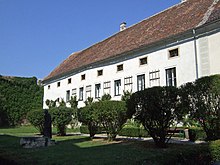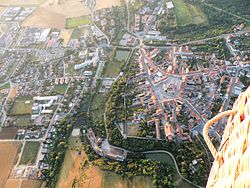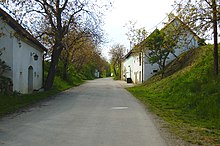Eggenburg
|
Borough Eggenburg
|
||
|---|---|---|
| coat of arms | Austria map | |
|
|
||
| Basic data | ||
| Country: | Austria | |
| State : | Lower Austria | |
| Political District : | horn | |
| License plate : | HO | |
| Surface: | 23.55 km² | |
| Coordinates : | 48 ° 39 ' N , 15 ° 49' E | |
| Height : | 329 m above sea level A. | |
| Residents : | 3,503 (January 1, 2020) | |
| Population density : | 149 inhabitants per km² | |
| Postal code : | 3730 | |
| Area code : | 02984 | |
| Community code : | 3 11 05 | |
| NUTS region | AT124 | |
| Address of the municipal administration: |
Kremserstraße 3 3730 Eggenburg |
|
| Website: | ||
| politics | ||
| Mayor : | Georg Gilli ( ÖVP ) | |
|
Municipal Council : ( 2020 ) (23 members) |
||
| Location of Eggenburg in the Horn district | ||
 Main square with the Trinity column |
||
| Source: Municipal data from Statistics Austria | ||
Eggenburg is a municipality with 3503 inhabitants (as of January 1, 2020) in the Horn district in Lower Austria .
geography
Eggenburg is located at the transition from the Weinviertel to the Waldviertel in Lower Austria. The area of the municipality covers 23.52 square kilometers. 11.59 percent of the area is forested.
Community structure
The municipality includes the following four localities (population in brackets as of January 1, 2020):
- Eggenburg (3064)
- Engelsdorf (102)
- Gauderndorf (97)
- Stoitzendorf (240)
The community consists of the cadastral communities Eggenburg, Engelsdorf, Gauderndorf, Stoitzendorf and Stoitzendorf Heide.
The municipality of Eggenburg is a member of the small region of Manhartsberg .
Neighboring communities
| Meiseldorf | Röschitz | |

|
||
| Burgschleinitz-Kühnring | Straning-Grafenberg |
history
Even in prehistoric times, the granite plateau above the Schmida, on which Eggenburg is founded, was inhabited by people from the younger Stone Age. The city was born in the Babenberger period (976–1246). After the turn of the millennium, Lower Austria was settled as far as the northern forest - today's Waldviertel. To secure this area, the fortified border town of Eggenburg was built around 1160/70 with a market function. Eginpurch was first mentioned in a document from the 12th century. In the dispute between Premysl Ottokar and Rudolf von Habsburg , Eggenburg sided with the Habsburgs, who on August 13, 1277, renewed the town's rights as a town.
In 1360, Rudolf IV of Austria prescribed the towns of Laa and Eggenburg and the Greitschenstein fortress to his wife Katharina to secure the property she had brought with him, as his father Duke Albrecht II had already done.
In the 15th and early 16th centuries, the city experienced a heyday despite the Hussite invasions (1428) and Hungarian occupation (1486–1490). The famous sgraffito house, also known as the "painted house", testifies to the self-confidence of the citizens. The town was re-fortified, and the mining and processing of the Zogelsdorf sandstone created a highly developed stonemasonry trade. In 1524 the citizens were able to successfully assert themselves in the dispute against the caretaker Ulrich von Haselbach and, in addition to the lower court, also won high or blood jurisdiction. A few years later the pledge of the castle and rule of Eggenburg fell to the Roggendorfer, who had the castle repaired, then to the barons of Meggau. In 1623 the rulership was sold to the Jesuits and later passed to Altenburg Abbey.
A fire disaster in 1808 caused the city to decline.
With the construction of the Franz-Josefs-Bahn in 1870, Eggenburg could be reached from Vienna in two hours. The population increased again, and with the garden city initiative of the merchant Franz Gamerith, the city was expanded.
Population development

In the last few decades the population remained constant despite the negative birth balance , as this was offset by a positive migration balance.
politics
The municipal council has 23 members.
- With the municipal council elections in Lower Austria in 1990, the municipal council had the following distribution: 16 ÖVP and 7 SPÖ.
- With the municipal council elections in Lower Austria in 1995, the municipal council had the following distribution: 11 ÖVP, 8 SPÖ and 4 EA-Eggenburg Aktiv.
- With the municipal council elections in Lower Austria in 2000, the municipal council had the following distribution: 13 ÖVP, 6 SPÖ, 2 FPÖ and 2 EA – Eggenburg Aktiv.
- With the municipal council elections in Lower Austria in 2005 , the municipal council had the following distribution: 15 ÖVP and 8 SPÖ.
- With the municipal elections in Lower Austria in 2010 , the municipal council had the following distribution: 16 ÖVP, 6 SPÖ and 1 FPÖ.
- With the municipal council elections in Lower Austria in 2015 , the municipal council had the following distribution: 16 ÖVP, 6 SPÖ and 1 FPÖ.
- With the municipal council elections in Lower Austria 2020 , the municipal council has the following distribution: 16 ÖVP, 6 SPÖ and 1 FPÖ.
- mayor
- 1760/1761 and 1765/1766 Johann Caspar Högl
- 1703–1707 Wolfgang Steinböck
- ? Andreas Steinböck (1665–1740)
- 1938–1945 Eduard Kranner
- until 2014 Willibald Jordan (ÖVP)
- since 2014 Georg Gilli (ÖVP)
Culture and sights
m
- Catholic parish church Eggenburg hl. Stephen: Romanesque towers, Gothic nave
- Karner: Ossuary, already mentioned in a document in 1299, the superstructure was demolished in 1792, found by excavation
- Redemptorist Monastery
- Martin's Chapel with Citizens Hospital: with a collection of tombstones
- City wall: The city wall has been almost completely preserved and is partially accessible
- Main square: Generous pentagonal main square and Grätzel with Gothic gabled houses, pillory, Martin's fountain, Marian column, baroque plague column
- Sgraffito house : sgraffito paintings from 1547
- John Nepomuk statue
- Vogelsangmühle : a baroque estate
- Chancellor's Tower: walk-in, furnished city wall tower, houses a museum of the Eggenburg Citizens' Corps
- Museums
- Krahuletz Museum : Museum in existence since 1902 with geological, prehistoric and folklore collections
- RRRollipop Museum: the RRRollipop Museum exhibits unusual small vehicles from the past. It is part of the Eggenburg nostalgia world, which focuses on the 1950s and 1960s. "129 scooters, scooter mobiles and mini cars" from the RRR collection - scooters, scooter mobiles & rarities were auctioned on July 10, 2020 in Vienna.
economy
In 2010 there were fifty agricultural and forestry holdings in the municipality (twelve fewer than in 1999), eighteen of which were full-time farms. In the production sector, 39 companies employed 561 people, mainly in the manufacture of goods (440), but also in construction (118). In the service sector, 205 companies employed 1,492 people, over 50 percent in social and public services and around a quarter in commerce.
education
In Eggenburg there are two kindergartens, an elementary school, a New Lower Austrian Music Middle School and a state vocational school.
health
- There is a pharmacy in the township and several general practitioners and specialists are ordained.
- Care: The state of Lower Austria operates a care and support center in Eggenburg.
- Companies
- Egston with around 1,800 employees.
traffic

- Road: The Retzer Straße (B35) leads from Krems through Eggenburg to beyond Retz to the border with the Czech Republic and crosses the city in a north-south direction. Another important regional road connection is the Waldviertler Straße (B2), which connects Eggenburg with Horn and Hollabrunn.
- Bus: The city is the starting point and destination of several regional bus routes operated by ÖBB-Postbus .
- Train: The Franz-Josefs-Bahn runs through Eggenburg . The ÖBB operate the Eggenburg station , which is an essential hub for commuters, especially those traveling to Tulln on the Danube and Vienna .
Personalities
Sons and daughters of the church
- Hannes Bauer (* 1941), politician (SPÖ) and former member of the National Council
- Friedl Fürnberg (1902–1978), General Secretary of the KPÖ
- Reichardt Fux (1654–1699), master stonemason and judge in the imperial quarry on Leithaberg
- Walter Gamerith (1903–1949), painter
- Burghard Gaspar (* 1947), professor, elementary school director, local researcher and author
- Adam Haresleben (1627–1683), 1654 master builder in St. Stephen's Cathedral in Vienna, 1656 and 1677 headmaster of the Viennese building works, born in Kühnring near Eggenburg
- Johann Georg Haresleben (1671–1716), master stonemason in the imperial quarry, born in Kühnring near Eggenburg
- Thomas Haresleben (1673–1733), master builder in St. Stephen's Cathedral in Vienna, head of the Wiener Bauhütte, born in Kühnring near Eggenburg
- Franz Hieß (1641–1675), master stonemason, born in Eggenburg
- Stefan Higatzberger (* 1965), handball player and sports manager
- Georg Andreas Högl (1714–1780), master stonemason and sculptor, head of the Wiener Bauhütte
- Johann Caspar Högl (1701–1776), master stonemason and sculptor
- Dominik Hofbauer (* 1990), soccer player
- Tony Jagitsch (* 1948), big band leader
- Elisabeth Kerschbaum (* 1966), politician of the Greens and former member of the Federal Council
- Matthias Knox (1645–1688), 1683 master builder in St. Stephen's Cathedral in Vienna, 1674/1686 headmaster of the Wiener Bauhütte, born in Kühnring near Eggenburg
- Ines Koch (* 1971), politician (ÖVP) and former member of the Vienna City Council
- Johann Krahuletz (1848–1928), prehistoric researcher
- Karl Borromäus Landsteiner (1835–1909), Catholic theologian, was born in the district of Stoitzendorf.
- Johann Marihart (* 1950), Manager and CEO of Agrana
- Barbara Neuwirth (* 1958), writer
- Karl Petrikovics (* 1954), former CEO of Immofinanz
- Tobias Schopf (* 1985), handball player
- Norbert Silberbauer (1959–2008), writer
- Burkhard Stangl (* 1960), musician
- Andreas Steinböck (1665–1740), mayor, master stonemason and sculptor
- Gabriel Steinböck (1705–1764), master stonemason
- Veith Steinböck (1656–1713), 1695 master builder of St. Stephen's Cathedral in Vienna, 1683/1684 head of the Viennese building works
- Wolfgang Steinböck (1650–1708), mayor, master stonemason and sculptor
- Johann Michael Strickner (1720–1782), master stonemason and judge in the imperial quarry
- Maria Teschler-Nicola (* 1950), anthropologist and human biologist
- Peter Vilnai (born 1945), actor
- Franz Zeilinger (* 1934), Catholic theologian
- Johann Zelebor (1819–1869), naturalist, illustrator and zoologist
- Gunter Ziegler (* 1949), actor
People related to the community
- Eggenburg Brotherhood , from 1629 independent guild association of stonemasons and stone sculptors
- Wolfgang Brandstetter (* 1957), lawyer, university professor, former Austrian Vice Chancellor and Minister of Justice, lives in Eggenburg
- Ernst Degasperi (1927–2011), artist, created the Kunsthaus - House of Peace in Eggenburg
- Johann Gallus Högl (1664–1719), master stonemason, lived and died in Eggenburg
- Eduard Kranner (1893–1977), writer and Nazi mayor of Eggenburg
- Josef Naderer (1906–1965), politician (ÖVP) and wine wholesaler, from 1934 to 1938 Vice Mayor of Eggenburg
- Arnulf Neuwirth (1912–2012), artist, lived in Eggenburg
- Heinrich Reinhart (1927–2013), doctor and local researcher, lived in Eggenburg
- Hans Seitz (1929–2011), city sponsor, committed to listed buildings
- Fritz F. Steininger (* 1939), geologist and paleontologist, chairman of the Krahuletz Society
- Angela Stifft-Gottlieb (1881–1941), prehistoric, headed the Krahuletz Museum
- Johann Baptist Stöger (1810–1883), lay brother of the Redemptorist Congregation, lived and died in Eggenburg
- Werner Vasicek (1939–2013), local history researcher and paleontologist, curator at the Krahuletz Museum
Web links
- 31105 - Eggenburg. Community data, Statistics Austria .
- City of Eggenburg
- Tourist information Eggenburg
- Krahuletz Museum
- RRRollipop Museum, Eggenburg nostalgia world
- Entry about Burg-Schloss Eggenburg on NÖ-Burgen online - Institute for Reality Studies of the Middle Ages and the Early Modern Era, University of Salzburg
- Entry on Eggenburg in the database of the state's memory of the history of Lower Austria ( Museum Niederösterreich )
- Literature about Eggenburg in the Lower Austrian State Library
- Pictures of Eggenburg in the topographical collection of the Lower Austrian regional library
Individual evidence
- ↑ Statistics Austria: Population on January 1st, 2020 by locality (area status on January 1st, 2020) , ( CSV )
- ↑ Austrian State Archives: AT-OeStA / HHStA UR AUR 2407 Brother Gottfried von Klingenfels, Johanniterordensmeister for Germany, Bohemia, Moravia, Poland, Austria and Styria, confirms the donation of 12 farmsteads and 2 fiefs in Eggenburg and 1 1/2 fiefs in Stinkenbrunn by Heinrich "Currith" to the Johanniterkomme. Retrieved April 4, 2020 .
- ↑ Austrian State Archives: AT-OeStA / HHStA UR AUR 2466 Countess Kunigunde von Niederschleinz exchanges her property in Neukirchen with the Dominican convent Imbach for the village "Richpolstorf" (Reipersdorf, GB Eggenburg)., 1292.10.19 (single item (document, picture, map , Certificate)). Retrieved April 4, 2020 .
- ↑ Austrian State Archives: AT-OeStA / HHStA UR FUK 156 Duke Albrecht II of Austria refers his daughter-in-law Katharina, wife of his son Duke Rudolf and daughter of Emperor Charles IV., For the 10,000 shocks of Prague groschen she brought with her as marriage goods as a repayment of 1,000 Prague Groschen di 1750 pounds. Retrieved April 4, 2020 .
- ↑ Austrian State Archives: AT-OeStA / HHStA UR FUK 166a Duke Rudolf IV. Of Austria prescribes the cities of Laa, Eggenburg and the festivals to his wife Katharina to secure her marriage goods, as his father Duke Albrecht II already did at one time Greitschenstein., 1360.12.13. Retrieved April 4, 2020 .
- ^ Digitalized version of the document [1] City seal 1364 [2]
- ↑ Austrian State Archives: AT-OeStA / HHStA UR AUR, 1465 VII 16 Emperor Friedrich informs Gamareth Fronauer that he has convened a common state parliament in Tulln next Monday after Sannd Larentzentag (1465 August 12), as the Principality of Austria has been for a long time with swern that are constantly growing, burdened i. Retrieved April 4, 2020 .
- ↑ Austrian State Archives: AT-OeStA / HHStA RK Maximiliana 2-2-117 Maximilian confirms judges, council and common citizens of Eggenburg their privileges, freedoms and festivities., 1493.12.20 (single item (file, picture, card, certificate)). Retrieved April 4, 2020 .
- ^ Museum of Lower Austria: Memory of the State - Places: Eggenburg. Retrieved April 4, 2020 .
- ^ Austrian State Archives: AT-OeSTA / HHStA LA KA 123-2 Privileges of the Eggenburg rule regarding jurisdiction and toll collection, 1524-1703 (file (collective file, basic number, bundle, dossier, file)). Retrieved April 4, 2020 .
- ^ Austrian State Archives: AT-OeSTA / HHStA LA KA 124-20 Regional jurisdiction of the Eggenburg rule, 1702-1705 (file (collective file, basic number, bundle, dossier, file)). Retrieved April 4, 2020 .
- ^ Austrian State Archives: AT-OeSTA / HHStA LA KA 128-8 Tax files of the Jesuit rule Eggenburg, 1653-1725 (file (collective file, basic number, bundle, dossier, file)). Retrieved April 4, 2020 .
- ^ Austrian State Archives: AT-OeSTA / HHStA LA KA 131-8 Lease of the Jesuit regional court in Eggenburg., 1615-1640 (file (collective file, basic number, bundle, dossier, file)). Retrieved April 4, 2020 .
- ^ Austrian State Archives: AT-OeSTA / HHStA LA KA 131-15 Contract between the Jesuit College. and the city of Eggenburg, 1676 (act (collective file, basic number, bundle, dossier, file)). Retrieved April 4, 2020 .
- ^ Austrian State Archives: AT-OeSTA / HHStA LA KA 125-6 Emperor Leopold I confirms to the Jesuit College. as rule of Eggenburg the toll justice, 1703 (act (collective act, basic number, bundle, dossier, file)). Retrieved April 4, 2020 .
- ^ Burghard Gaspar: The founding of the garden city Eggenburg. The life's work of the Eggenburg businessman Franz Gamerith, special edition of the cultural department of the city of Eggenburg, from: Das Waldviertel Heft 3 1991.
- ^ Statistics Austria, A look at the community of Eggenburg, population development. Retrieved September 26, 2019 .
- ^ Result of the local council election 1995 in Eggenburg. Office of the Lower Austrian State Government, March 30, 2000, accessed April 5, 2020 .
- ^ Election result of the municipal council election 2000 in Eggenburg. Office of the Lower Austrian State Government, February 4, 2005, accessed April 5, 2020 .
- ^ Election result of the municipal council election 2005 in Eggenburg. Office of the Lower Austrian State Government, March 4, 2005, accessed on April 5, 2020 .
- ^ Election result of the municipal council election 2010 in Eggenburg. Office of the Lower Austrian State Government, October 8, 2010, accessed on April 5, 2020 .
- ^ Election results for the 2015 municipal council elections in Eggenburg. Office of the Lower Austrian State Government, December 1, 2015, accessed on February 25, 2020 .
- ↑ Results of the municipal council election 2020 in Eggenburg. Office of the Lower Austrian State Government, January 26, 2020, accessed on February 25, 2020 .
- ↑ nostalgia. Retrieved June 1, 2019 .
- ↑ Statistics Austria, A look at the municipality of Eggenburg, agricultural and forestry operations. Retrieved September 26, 2019 .
- ^ Statistics Austria, A look at the community of Eggenburg, workplaces. Retrieved September 26, 2019 .
- ^ Statistics Austria, A look at the community Eggenburg, workers. Retrieved September 26, 2019 .
- ^ Community Eggenburg, institutions, educational institutions. Retrieved September 26, 2019 .
- ^ Community Eggenburg, facilities, health facilities. Retrieved September 26, 2019 .
- ^ Province of Lower Austria, Care and Support Center Eggenburg. Retrieved September 26, 2019 .













